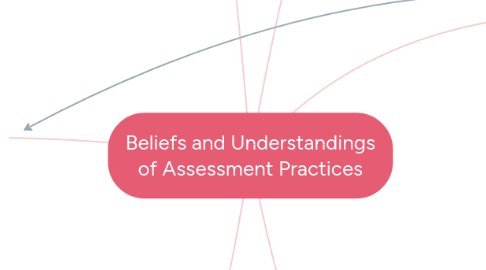
1. Relationship Between Assessment, Curriculum, & Instruction
1.1. Assessment
1.1.1. Purposes of Assessment
1.1.1.1. Comparisons among test-takers
1.1.1.2. Improvement of ongoing instruction and learning
1.1.1.3. Evaluation of instruction
1.1.2. Multiple types of assessment
1.2. Curriculum
1.2.1. Evaluating Curriculum
1.2.1.1. Tyler's Objectives-Centered Model
1.2.1.1.1. focuses attention on curricular strengths and weaknesses
1.2.1.1.2. emphasizes continuous cycle of assessment, analysis, and improvement
1.2.1.2. Stufflebeam's Context, Input, Process, Product Model
1.2.1.2.1. emphasis on appropriate decisions for improving curricula
1.2.1.3. Scriven's Goal-Free Model
1.2.1.3.1. first to question the assumption that goals or objectives are crucial in the evaluation process
1.2.1.4. Stake's Responsive Model
1.2.1.4.1. flexible
1.2.1.4.2. if used effectively should result in high utility
1.2.1.5. Eisner's Connoisseurship Model
1.2.1.5.1. three aspects: descriptive, interpretive, evaluative
1.2.1.6. Bradley's Effectiveness Model
1.2.1.6.1. 10 key indicators that can be used to measure the effectiveness of a developed curriculum
1.3. Instruction
1.3.1. all methods used to present information to learners
2. Useable assessments need both validity and reliability
2.1. Reliability
2.1.1. consistency of measurement
2.1.2. Types of reliability indicators
2.1.2.1. Test-retest evidence
2.1.2.1.1. the degree to which test-taker’s scores are similar on two time-separated administrations of the same test
2.1.2.1.2. correlation coefficient indicates stability of scores
2.1.2.2. Alternate-form evidence
2.1.2.2.1. reliability evidence indicative of the degree to which two alleged versions of the same test are functioning similarly
2.1.2.2.2. requires a sample of likely test-takers to complete two forms of a test, then calculate the correlation coefficient
2.1.2.3. Internal consistency evidence
2.1.2.3.1. a type of reliability evidence focused on the degree to which a test’s items appear to be measuring the same construct
2.1.2.3.2. particularly important when a test is built so that all items intended measure the same thing
2.2. Validity
2.2.1. the degree to which evidence and theory support the interpretations of a test scores for proposed uses of tests
2.2.2. a valid test measures student learning over topics they’ve been taught
3. Grading
3.1. Role of Grading
3.1.1. document progress
3.1.2. provide feedback to student, family, and teacher
3.1.3. inform instructional decisions
3.1.4. motivate students
3.1.4.1. low grades do not motivate students to do better; low grades prompt students to withdraw from learning
3.1.4.2. high grades create a small bump in motivation, but it is short-lived
3.1.5. punish students
3.1.6. sort students
3.2. Impact of Grading
3.2.1. participation grades
3.2.1.1. is participation a technique used to learn the standards, or the standard itself?
3.2.1.2. advisable to include feedback on participation, but not as a formal grade
3.2.1.3. grades for requiring students to be at events after school is over is coercion and bribery
3.2.2. grading effort and behavior
3.2.2.1. high correlation between academic success and effort, behavior, attendance
3.2.2.2. effort, hard-work, behavior, and self-discipline can be taught many ways, not just through grades
4. Types of Assessments
4.1. Pre-Assessment
4.1.1. provides knowledge about students’ varied readiness levels and from this data
4.1.2. teachers can construct a learning course that best meets everyone’s needs
4.1.3. provides a baseline of understanding and motivation for learning for students
4.2. Formative Assessment
4.2.1. a planned process in which assessment-elicited evidence of students’ status is used by teachers to adjust their ongoing instructional procedures or by students to adjust their learning tactic
4.2.2. a significant educational outcome sought for students, usually after an instructional period of some duration
4.2.3. Examples
4.2.3.1. Quickwrites
4.2.3.2. Exit tickets or tickets out the door
4.2.3.3. Audience response system, thumbs up or down, rating scales
4.2.3.4. Practice problems
4.2.3.5. Graphic organizers
4.3. Summative Assesment
4.3.1. Achievement tests
4.3.1.1. not intended to measure students' future success, but tests students' mastery of particular subject matter
4.3.1.2. SAT
4.3.1.3. ACT
4.3.1.4. Georgia Milestones End of Course Test
4.3.1.5. Georgia Milestones End of Grade Test
4.4. Assessments Outside of the Classroom
4.4.1. Aptitude tests
4.4.1.1. a test designed to predict test takers' performances in a subsequent setting
5. Assessment Models, Theories, & Applications
5.1. Helpful assessments
5.1.1. is varied
5.1.2. is authentic
5.1.3. can be tiered
5.1.4. advances learning, not only documents it
5.1.5. are substantive and avoid fluff
5.1.6. reveal the student's story
5.1.7. makes an effort to be valid and reliable
6. Assessments should be fair and impartial
6.1. Construct-irrelevant variance
6.1.1. variations in students’ scores attributable to extraneous factors that distort the meaning of such scores
6.1.1.1. Gender
6.1.1.2. Race
6.1.1.3. Ethnicity
6.1.1.4. Socioeconomic status
6.1.1.5. Religion
6.2. Assessment bias
6.2.1. indicates whether an educational test offends or unfairly penalizes a test-taker
6.2.2. Accessibility
6.2.2.1. the extent to which students are easily able to display their optimal performance regarding whatever is being assessed via a test
6.2.2.2. ESOL students being asked to display mathematical skills using English terms they do not fully understand
6.2.3. Universal design
6.2.3.1. a strategy for developing educational assessments that, from the earliest moments of the test-development process, strives to maximize the accessibility of a test for all of its intended users
6.3. Accommodations
6.3.1. adjustments made at any point in the assessment process that do not alter the fundamental nature of the content being assessed
6.3.2. Examples
6.3.2.1. Extended time
6.3.2.2. Read aloud
6.3.2.3. Small group
6.3.2.4. Bilingual or word-to-word dictionary
